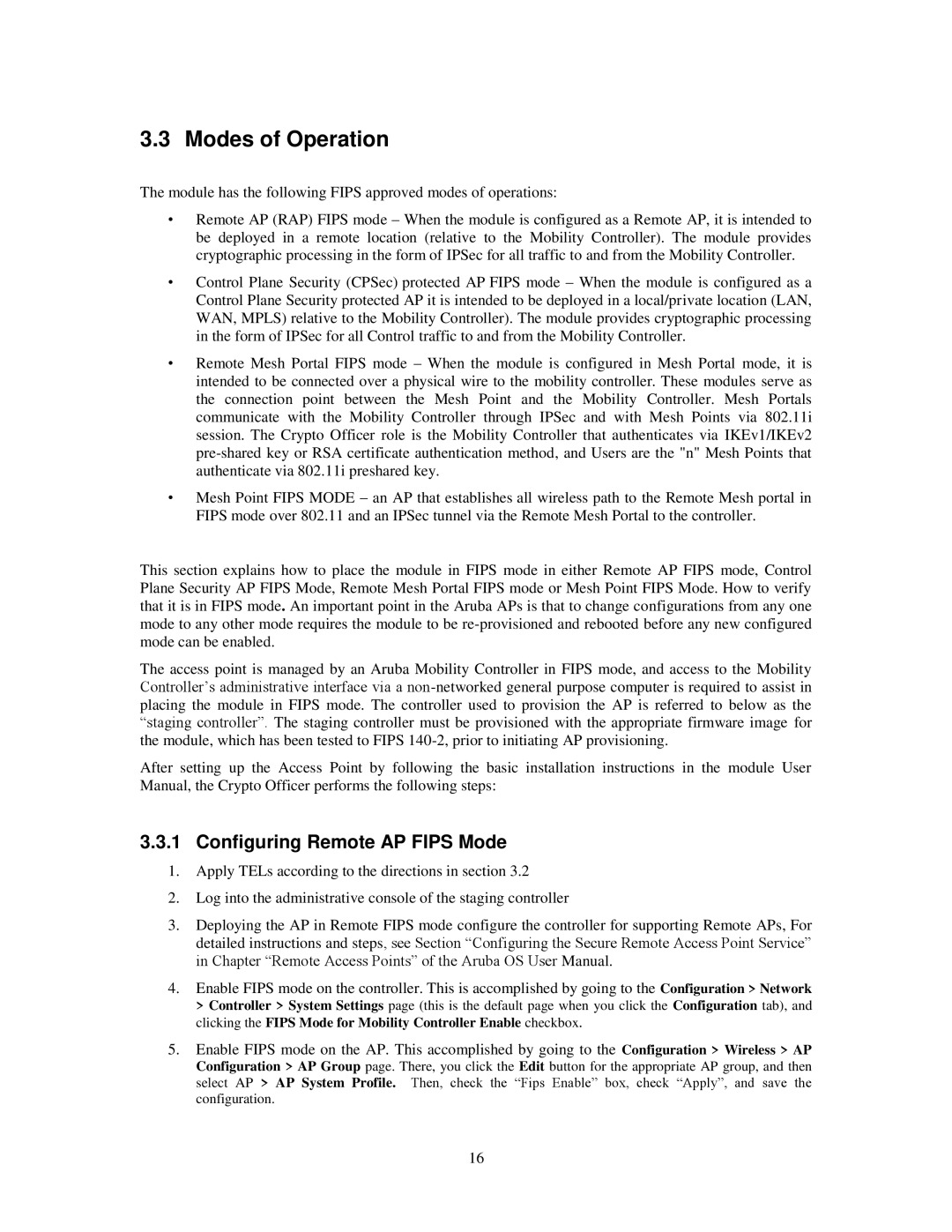3.3 Modes of Operation
The module has the following FIPS approved modes of operations:
•Remote AP (RAP) FIPS mode – When the module is configured as a Remote AP, it is intended to be deployed in a remote location (relative to the Mobility Controller). The module provides cryptographic processing in the form of IPSec for all traffic to and from the Mobility Controller.
•Control Plane Security (CPSec) protected AP FIPS mode – When the module is configured as a Control Plane Security protected AP it is intended to be deployed in a local/private location (LAN, WAN, MPLS) relative to the Mobility Controller). The module provides cryptographic processing in the form of IPSec for all Control traffic to and from the Mobility Controller.
•Remote Mesh Portal FIPS mode – When the module is configured in Mesh Portal mode, it is intended to be connected over a physical wire to the mobility controller. These modules serve as the connection point between the Mesh Point and the Mobility Controller. Mesh Portals communicate with the Mobility Controller through IPSec and with Mesh Points via 802.11i session. The Crypto Officer role is the Mobility Controller that authenticates via IKEv1/IKEv2
•Mesh Point FIPS MODE – an AP that establishes all wireless path to the Remote Mesh portal in FIPS mode over 802.11 and an IPSec tunnel via the Remote Mesh Portal to the controller.
This section explains how to place the module in FIPS mode in either Remote AP FIPS mode, Control Plane Security AP FIPS Mode, Remote Mesh Portal FIPS mode or Mesh Point FIPS Mode. How to verify that it is in FIPS mode. An important point in the Aruba APs is that to change configurations from any one mode to any other mode requires the module to be
The access point is managed by an Aruba Mobility Controller in FIPS mode, and access to the Mobility Controller’s administrative interface via a
After setting up the Access Point by following the basic installation instructions in the module User Manual, the Crypto Officer performs the following steps:
3.3.1 Configuring Remote AP FIPS Mode
1.Apply TELs according to the directions in section 3.2
2.Log into the administrative console of the staging controller
3.Deploying the AP in Remote FIPS mode configure the controller for supporting Remote APs, For detailed instructions and steps, see Section “Configuring the Secure Remote Access Point Service” in Chapter “Remote Access Points” of the Aruba OS User Manual.
4.Enable FIPS mode on the controller. This is accomplished by going to the Configuration > Network > Controller > System Settings page (this is the default page when you click the Configuration tab), and clicking the FIPS Mode for Mobility Controller Enable checkbox.
5.Enable FIPS mode on the AP. This accomplished by going to the Configuration > Wireless > AP Configuration > AP Group page. There, you click the Edit button for the appropriate AP group, and then select AP > AP System Profile. Then, check the “Fips Enable” box, check “Apply”, and save the configuration.
16
